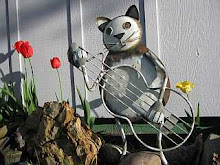Recent a fine fellow from Ireland came across one of my old posts about my wood stove and my cleaning of the ash in the pipe and he left a comment.
http://tallpinesranch.blogspot.com/2011/12/cleaning-ash.html
He has an interesting blog about his personal and critical look at sustainable energy and I gave him permission to use my photos and words in one of his posts.
http://wood-pellet-ireland.blogspot.com/2012/03/stoves-flue-pipes-and-cleaning.html
I had a few more comments for him and decided since I once again got carried away with words, I would just write them in a post of my own.
Hi Tony,
Thanks for your concern. I do keep an eye on the ash buildup.
Also every summer I thoroughly clean the pipe and chimney. In addition to a wire chimney brush, I use scraping tools to remove any signs of creosote forming as that is bad stuff. I tend to only see signs of hard creosote starting in the chimney itself. I don't know why. Perhaps it is because the air cools the further it gets from the stove slowing the movement of the ash. Perhaps it is because I clean the chimney itself only once a year as there is much, much less ash buildup than in the horizontal flue.
During the earlier cleaning I didn't take photos of the vertical column of pipe from the wood stove. There was very little ash buildup in that pipe. Also, the chimney - which is further from the heat - also had little ash.
I've heard a way of reducing creosote buildup is to have your fire burn hot as there is less smoke and therefore less ash/creosote buildup. It is bad to let your fire burn at a low level or to let the wood smolder.
A word of caution about a hot fire is to ensure you do not have a creosote buildup prior to burning a very hot fire. It may take a hotter fire to ignite creosote (a theory... as fortunately I have had no experience of this happening to me), but I imagine once creosote ignites it is difficult to extinguish.
I've heard another way of reducing creosote buildup is via the wood used. I wonder if greener (not as dry) wood would contribute to more creosote as greener wood is more likely to smolder.
I sometimes use wood from Western Larch trees which are heavy with sap and oils. I am not sure if you read my blog posts about burning tree stumps. Larch stumps are harder to get burning, but once they 'take' I've had their stumps burn for days as the fire follows the roots underground to their very end. Occasionally I undercover larch stumps in my pasture that have been buried for decades and they show little signs of decay due to their oils and pitch content.
Something that runs counter to what I just said about a hot fire... when I burn Western Larch in my wood stove I use much smaller pieces than normal as this Larch burns very hot. Afterwards I notice lots of black soot on the glass window to my stove, something I do not usually see when burning other forms of wood.
You probably knew all this already, so I'll shut up now.
Thanks.
Tuesday, March 06, 2012
Subscribe to:
Post Comments (Atom)


No comments:
Post a Comment